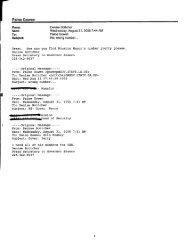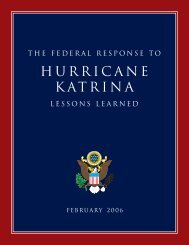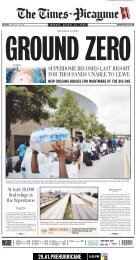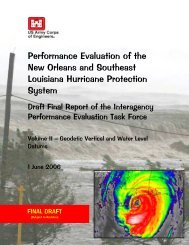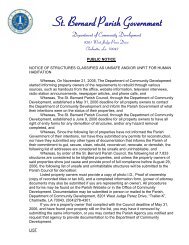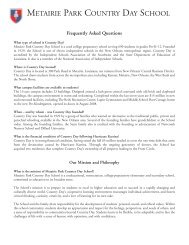IPET Report 3 Vol VIII
IPET Report 3 Vol VIII
IPET Report 3 Vol VIII
Create successful ePaper yourself
Turn your PDF publications into a flip-book with our unique Google optimized e-Paper software.
Rainfall Intensity<br />
Rainfall is among the variables that affect the inundation of the basins. While rainfall is not<br />
of primary concern for the hurricane protection system, it is a contributor to the frequency of<br />
low-level flood losses. Hence it was decided that a relatively coarse model of hurricane-induced<br />
rainfall would suffice.<br />
Prior to NASA’s Tropical Rainfall Measuring Mission (TRMM) (Simpson et al. 1988),<br />
information on hurricane rainfall was scanty. The TRMM mission, which started in November<br />
1997, produced vast amounts of rainfall estimates for tropical storms and hurricanes at a spatial<br />
scale of about 5 km in various tropical regions, including the Atlantic basin. These rainfall<br />
products have been analyzed statistically by Lonfat et al. (2004) and Chen et al. (2006). The<br />
model used is based primarily on these two studies and on discussions with Dr. Shuyi Chen at<br />
the University of Miami. The model is described in detail in Appendix 8.<br />
Assessment of Rainfall Intensity Inside the Basins. A simplified model of rainfall inside<br />
the basins was developed as described in Appendix 8. First the mean rainfall contribution from<br />
the symmetric component of the mean rain field was selected. Next the asymmetric component<br />
and finally the variability of rainfall around the mean were assessed.<br />
For hurricanes that pass to the right or near the basin, the azimuthal dependence of the rainfall<br />
field is conservatively neglected. For hurricanes that pass to the left of a basin, the asymmetric<br />
component is accounted for by multiplying the above symmetric mean rainfall values by<br />
1.5. This factor includes intensification due to land effects.<br />
Uncertainty is expressed by a lognormal random variable with mean value 1 and log standard<br />
deviation 0.69, which corresponds to an uncertainty factor of 2. This random factor is applied to<br />
the entire mean rainfall time history. In reality, rainfall intensity inside a basin would display<br />
significant fluctuations in time and space, which locally could far exceed a factor of 2. However,<br />
the above random factor is considered adequate to reflect uncertainty on the total precipitation in<br />
a basin during the passage of a hurricane.<br />
Epistemic Uncertainty<br />
Epistemic uncertainty (uncertainty due to limited information and knowledge) affects all<br />
aspects of the hazard characterization. While a thorough assessment of these uncertainties is<br />
beyond the scope of this project, a rough quantification of uncertainty on the hurricane rates and<br />
the loads was made.<br />
General Considerations. The hurricane rates are uncertain due to the limited historical<br />
sample size, possible errors in the assumed form of marginal and conditional distributions<br />
(especially in the tail regions), and the uncertain near-future hurricane activity due to fluctuations<br />
and trends associated with climate changes and multi-decadal cycles. A first-order assessment<br />
of uncertainty on hurricane rates is based on the hurricane effects of global warming and<br />
shorter-term climatic fluctuations in the North Atlantic.<br />
<strong>Vol</strong>ume <strong>VIII</strong> Engineering and Operational Risk and Reliability Analysis <strong>VIII</strong>-37<br />
This is a preliminary report subject to revision; it does not contain final conclusions of the United States Army Corps of Engineers.



